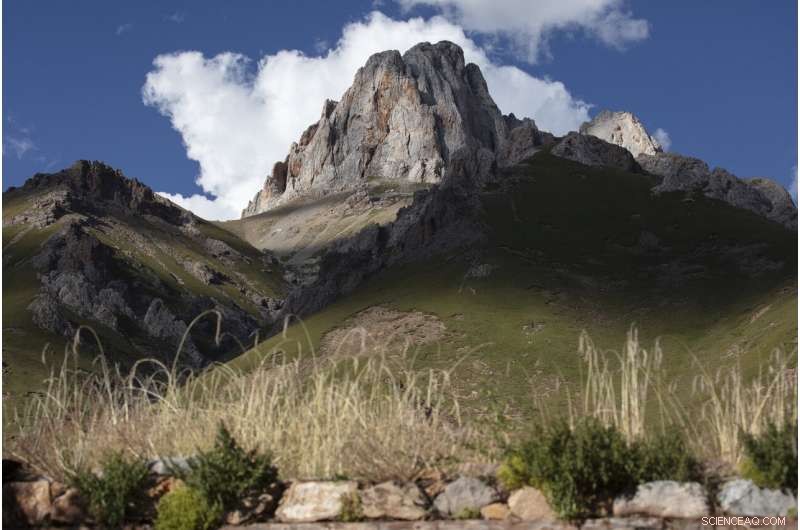
I picchi raggiungono il cielo ad Angsai, domenica un'area all'interno della regione di Sanjiangyuan nella provincia occidentale del Qinghai, 25 agosto 2019. Circondato dalle catene montuose più alte del mondo, la regione a lungo conosciuta come "il tetto del mondo" è ora nel mirino dell'ultima spinta di modernizzazione della Cina. Ma questa volta, il governo cinese vuole porre dei limiti alla crescita della regione al fine di implementare la propria versione di una delle eredità più orgogliose degli Stati Uniti:un sistema di parchi nazionali. (Foto AP/Ng Han Guan)
C'è un boom edilizio sull'altopiano tibetano, uno degli ultimi luoghi remoti del mondo. Le montagne a lungo coronate da ghirlande di bandiere di preghiera svolazzanti, una tradizionale benedizione del paesaggio, sono state recentemente sormontate da tentacolari linee elettriche in acciaio. Di notte, le insegne luminose delle stazioni di servizio di Sinopec proiettavano un bagliore rosso sulle autostrade di nuova costruzione.
Circondato dalle catene montuose più alte del mondo, la regione a lungo conosciuta come "il tetto del mondo" è ora nel mirino dell'ultima spinta di modernizzazione della Cina, segnato dalla moltiplicazione dei grattacieli e dall'espansione delle linee ferroviarie ad alta velocità.
Ma questa volta, c'è una differenza:il governo cinese vuole anche porre dei limiti alla crescita della regione per progettare la propria versione di una delle eredità più orgogliose degli Stati Uniti:un sistema di parchi nazionali.
In agosto, politici e scienziati cinesi, gli Stati Uniti e altri paesi riuniti a Xining, capitale della provincia del Qinghai, discutere i piani della Cina per creare un sistema di parchi unificato con standard chiari per limitare lo sviluppo e proteggere gli ecosistemi.
L'economia del paese è cresciuta negli ultimi 40 anni, ma le priorità si stanno espandendo per includere la conservazione delle risorse naturali chiave, dice Zhu Chunquan, il rappresentante cinese dell'Unione internazionale per la conservazione della natura, un gruppo scientifico con sede in Svizzera.
"È abbastanza urgente identificare al più presto i luoghi, gli ecosistemi e le altre caratteristiche naturali" da proteggere, dice Zhu.

Una donna tibetana assiste un bambino ad Angsai, domenica un'area all'interno della regione di Sanjiangyuan nella provincia occidentale del Qinghai, 25 agosto 2019. Una domanda chiave incombe sul progetto dei parchi nazionali del paese:la Cina può sposare gli obiettivi di conservazione e turismo, salvaguardando i mezzi di sussistenza e la cultura dei circa 128, 000 persone che vivono all'interno o in prossimità dei confini del parco, molti di loro tibetani? (Foto AP/Ng Han Guan)
Tra gli altri obiettivi, La Cina mira a costruire la propria Yellowstone sull'altopiano tibetano.
Zhu fa parte di un comitato consultivo che fornisce input sullo sviluppo del nascente sistema di parchi nazionali cinesi, dovrebbe essere presentato ufficialmente nel 2020. Funzionari cinesi hanno anche visitato i parchi nazionali degli Stati Uniti, tra cui Yellowstone e Yosemite, e cercato input da varie organizzazioni, tra cui il Paulson Institute di Chicago e il Nature Conservancy.
L'ambizione di creare un sistema di parchi unificato rappresenta "un nuovo e serio sforzo per salvaguardare la biodiversità e il patrimonio naturale della Cina, "Dice l'ecologo della Duke University Stuart Pimm.
Uno dei primi parchi pilota sarà in Qinghai, una vasta regione della Cina occidentale confinante con il Tibet e che condivide gran parte della sua eredità culturale. L'area ospita anche specie iconiche e minacciate come il leopardo delle nevi e il gatto di montagna cinese, e comprende le sorgenti di tre dei grandi corsi d'acqua dell'Asia:lo Yangtze, Fiumi Giallo e Mekong.
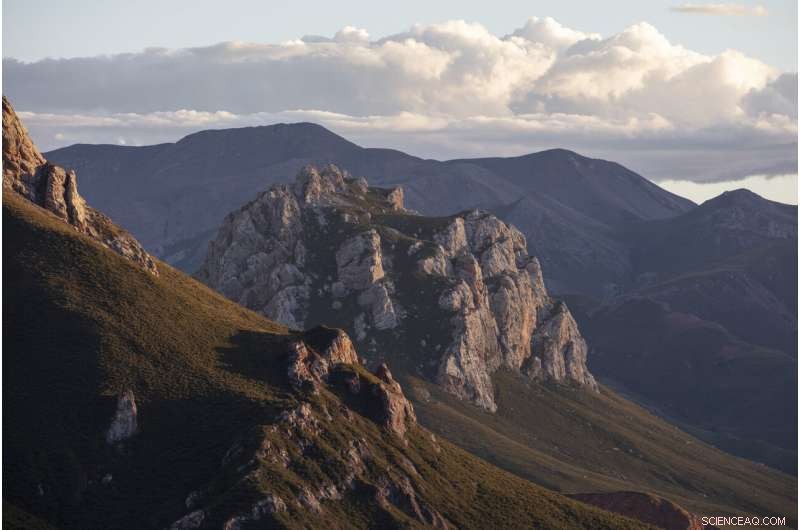
Le nuvole si librano sul paesaggio montuoso di Angsai, domenica un'area all'interno della regione di Sanjiangyuan nella provincia occidentale del Qinghai, 25 agosto 2019. La Cina mira a costruire la propria Yellowstone sull'altopiano tibetano. (Foto AP/Ng Han Guan)
"Questa è una delle regioni più speciali della Cina, nel mondo, "dice Lu Zhi, un biologo della conservazione dell'Università di Pechino che ha lavorato nel Qinghai per due decenni.
Mentre la costruzione continua a ritmo frenetico altrove sull'altopiano tibetano, il governo ha già smesso di rilasciare permessi minerari e idroelettrici in questa regione.
Ma una domanda chiave incombe sul progetto:la Cina può sposare gli obiettivi di conservazione e turismo, salvaguardando i mezzi di sussistenza e la cultura dei circa 128, 000 persone che vivono all'interno o in prossimità dei confini del parco, molti di loro tibetani?
"La Cina ha una popolazione densa e una lunga storia, " Zhu dice. "Una delle caratteristiche uniche dei parchi nazionali cinesi è che hanno persone locali che vivono all'interno o nelle vicinanze".
Yellowstone è ampiamente considerato il primo parco nazionale del mondo. Dopo essere stato creato nel 1872, il governo degli Stati Uniti ha costretto i nativi americani che vivevano nell'area a stabilirsi al di fuori dei confini del parco, in linea con l'idea del 19° secolo che la protezione della natura selvaggia significasse la natura separata dalle persone. Ma i paesi che tentano di istituire sistemi di parchi nel 21° secolo ora devono considerare il modo migliore per includere le popolazioni locali nella loro pianificazione.
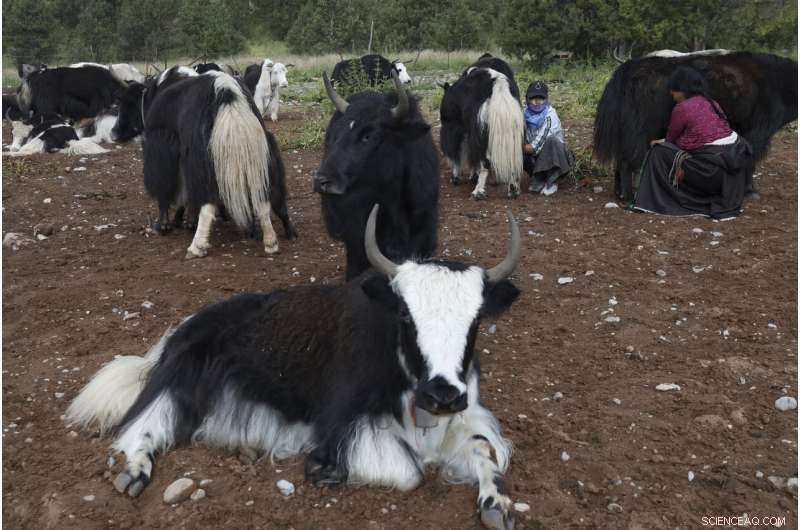
Le donne tibetane mungono i loro yak ad Angsai, domenica un'area all'interno della regione di Sanjiangyuan nella provincia occidentale del Qinghai, 25 agosto 2019. Il Qinghai è una vasta regione della Cina occidentale confinante con il Tibet e condivide gran parte della sua eredità culturale. (Foto AP/Ng Han Guan)
"Capire come ottenere la conservazione ecologica e il supporto per le comunità allo stesso tempo, questo è il problema più complicato che hai, "dice Jonathan Jarvis, un ex direttore del National Park Service degli Stati Uniti e ora professore dell'Università della California, Berkeley, che ha visitato il parco pilota del Qinghai, chiamato Sanjiangyuan.
La Cina ha precedentemente intrapreso vasti programmi di reinsediamento per liberare terreni per grandi progetti infrastrutturali, come la diga delle Tre Gole e il progetto di trasferimento dell'acqua da sud a nord. Questi reinsediamenti hanno lasciato molti agricoltori in nuove case senza campi agricoli adeguati o accesso ad altri mezzi di sussistenza.
Ma nello sviluppo dei parchi nazionali, il governo sta dando lavori legati alla conservazione ad almeno una fascia di persone che vivono a Sanjiangyuan per rimanere e lavorare nella loro terra. La "Una Famiglia, One Ranger" program hires one person per family for 1800 yuan a month ($255) to perform such tasks as collecting trash and monitoring for poaching or illegal grazing activity.
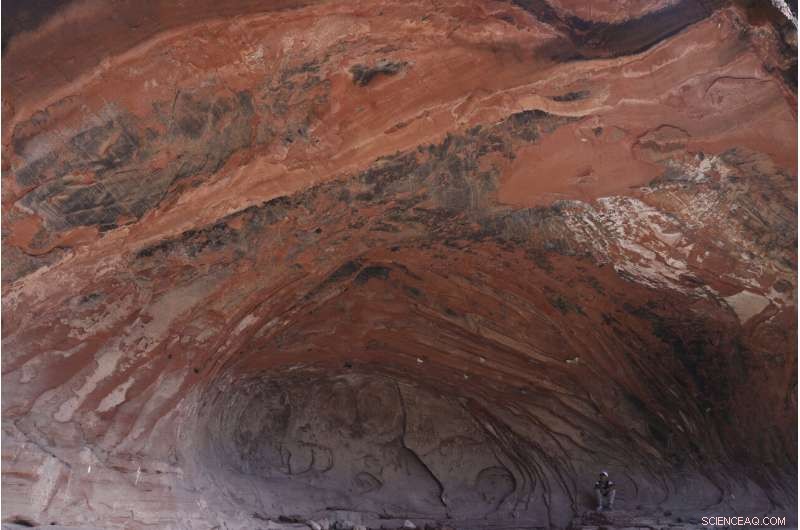
A Tibetan youth sits at the base of a natural cave formation in Angsai, an area inside the Sanjiangyuan region in western China's Qinghai province on Sunday, Aug. 25, 2019. China has previously undertaken vast resettlement programs to clear land for large infrastructure projects, but in developing the national parks, the government is giving conservation-related jobs to at least a swath of people living in Sanjiangyuan to stay and work on their land. (AP Photo/Ng Han Guan)
It's difficult to interview residents in China's ethnic borderlands like Qinghai, due to restrictions on journalists that make it hard to travel widely or freely in those areas. Regions with large ethnic and religious minorities, including all Tibetan areas, are subject to heightened political and religious controls.
But a few people living in Angsai, a Tibetan village located within the new Qinghai park, were willing to speak, although it's not possible to determine if their experiences are typical.
A-Ta is a Tibetan herder whose income largely comes from raising yaks and collecting caterpillar fungus, a folk medicine taken as a purported aphrodisiac or for respiratory problems. He also leads a team of trash collectors, traveling as much as 34 kilometers (21 miles) a day to comb the hillsides for plastic bottles and other waste as part of the "One Family, One Ranger" program.

A-Ta, at right stands near his father in their home in Angsai, an area inside the Sanjiangyuan region in western China's Qinghai province on Monday, Aug. 26, 2019. A-Ta, a Tibetan herder whose income largely comes from raising yaks and collecting caterpillar fungus, also leads a team of trash collectors traveling as much as 34 kilometers (21 miles) a day to comb the hillsides for plastic bottles and other waste, as part of the "One Family, One Ranger" program. (AP Photo/Ng Han Guan)
"I am living in this land, my living is relying on this land, " lui dice, as his sister heats a kettle in their modest home. A poster showing the faces of China's past leaders and current Communist Party general secretary, Xi Jinping, hangs on the wall.
A-Ta says he is grateful for work that allows his family to stay on their land, even as people in other parts of Qinghai have had to leave. His own son is employed leading a relocation program for "a huge population of nomads" in Dzarto, a county in southern Qinghai.
"I love this land very much, " he says. "I always motivate and encourage people to protect the environment and contribute to the conservation work."
Kunchok Jangtse is a Tibetan herder who also earns money cleaning up rubbish through the "One Family, One Ranger" program.
He has an additional volunteer position through the Chinese nonprofit Shanshui—the name means "mountain, water"—installing and maintaining motion-activated camera traps, which help scientists monitor endangered species in Qinghai.
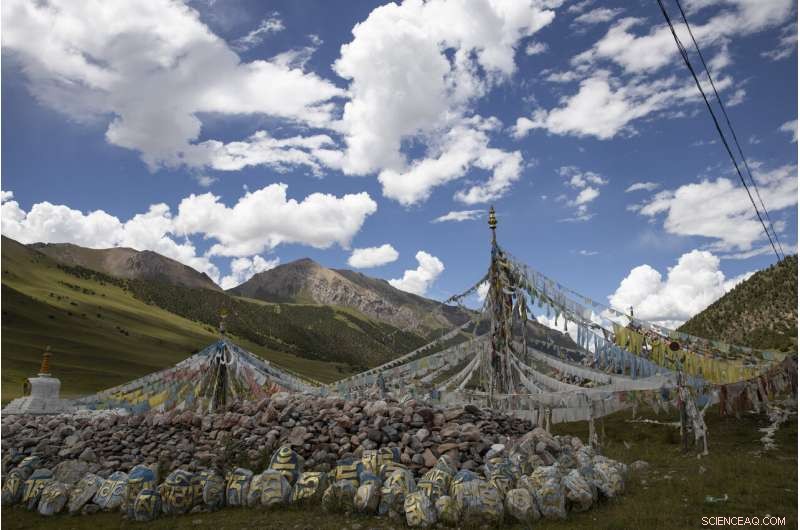
Tibetan prayer flags are seen during a clear day in Angsai, an area inside the Sanjiangyuan region in western China's Qinghai province on Monday, Aug. 26, 2019. Qinghai is a vast region in western China abutting Tibet and shares much of its cultural legacy. (AP Photo/Ng Han Guan)
As he affixes a camera trap to a thin tree trunk, he explains, "The reason why it has to be installed in this location is because this is the main migration route of the majority of wild animals."
Such camera traps have captured rare footage of snow leopards and Chinese mountain cats, including mothers and their cubs playing near a temporary den.
Kunchok Jangtse says the work of protecting the environment, including reporting illegal poaching activity, is important.
"Our religion is connected with wild animals, because wild animals have a consciousness and can feel love and compassion—therefore, we protect wild-animals, " lui dice.
From his main work raising livestock and collecting caterpillar fungus, Kunchok Jangtse says he can make about 20, 000 yuan ($2, 830) a year. He is grateful for the additional income from the ranger program, but mainly hopes his other livelihood won't be impeded—and that he won't eventually be forced to leave.
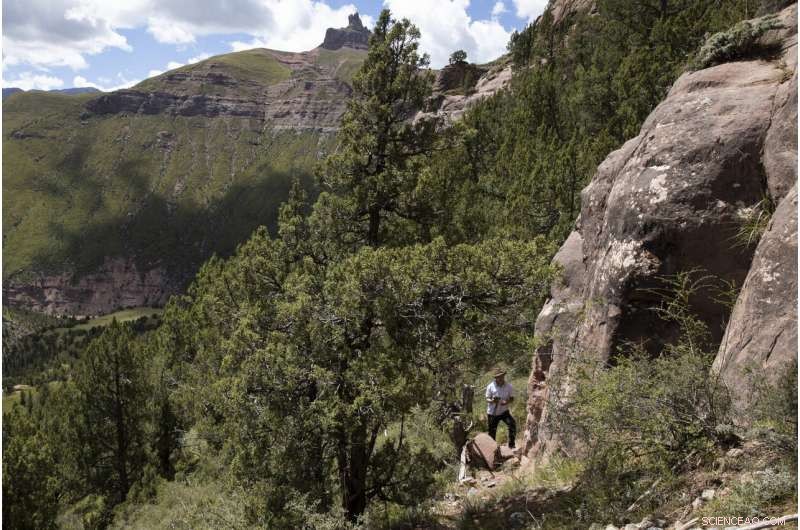
Kunchok Jangtse, a Tibetan herder who also instals and maintains motion-activated cameras, works on a camera in Angsai, an area inside the Sanjiangyuan region in western China's Qinghai province on Tuesday, 27 agosto 2019. His work helps scientists monitor endangered species. "I'm not a highly educated person, and I am very concerned it may bring many difficulties in my life if I would switch my job and move to another place, " he says. (AP Photo/Ng Han Guan)
"I'm not a highly educated person, and I am very concerned it may bring many difficulties in my life if I would switch my job and move to another place, " lui dice.
The question of local people's culture and livelihoods is one of the top concerns that former U.S. National Park Service director Jarvis says China has to wrestle with, along with establishing laws and funding.
"They need a legal framework that defines what a park is, " Jarvis says. "And they need sustainable funding."
The creation of protected areas is not a new idea in China. Infatti, roughly 15% of the country's land already is assigned to a bewildering patchwork of local and regional parks. But many existing reserves are simply parks on paper, run by various agencies without enforceable guidelines.
In contrasto, the national parks system is being designed from the ground-up to incorporate global best practices and new science.
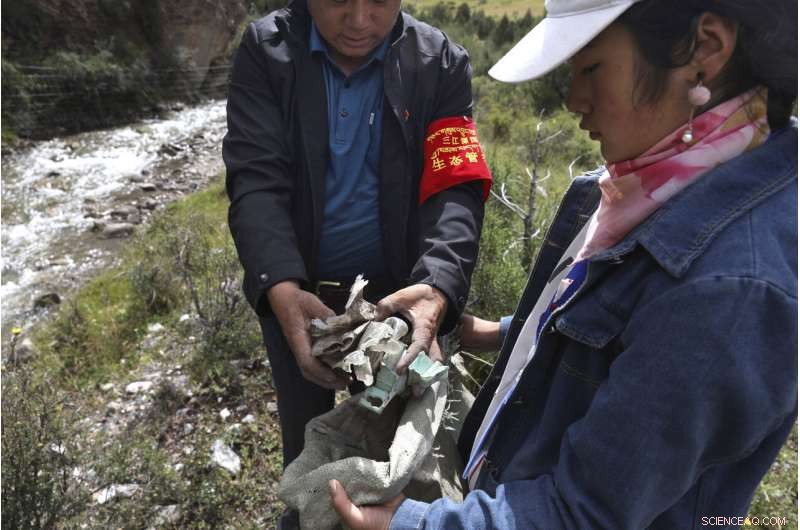
A-Ta, a Tibetan herder whose income largely comes from raising yaks and collecting caterpillar fungus, places refuse in a bag as he leads his team of trash collectors in Angsai, an area inside the Sanjiangyuan region in western China's Qinghai province on Monday, Aug. 26, 2019. His team travels as much as 34 kilometers (21 miles) a day to comb the hillsides for plastic bottles and other waste, as part of the "One Family, One Ranger" program. "I am living in this land, my living is relying on this land, " he says. (AP Photo/Ng Han Guan)
In his office in Beijing, Ouyang Zhiyun, deputy director at the Chinese Academy of Sciences' Research Center for Eco-Environmental Sciences, pores over hundreds of carefully shaded maps of mainland China that denote priority areas for protecting threatened and endangered species, as well as "eco-system services, " like safeguarding water supplies and limiting soil erosion.
The question isn't just how much total land you're protecting, but which lands you're protecting, he notes.
Recentemente, Ouyang was the lead scientist for China's sweeping "national ecosystems assessment, " which used 20, 000 satellite images and 100, 000 field surveys to examine how China's land changed between 2000 and 2010, with some of the findings published in the journal Science in 2016. One resulting statistic:China's urban area increased 28% during that period.
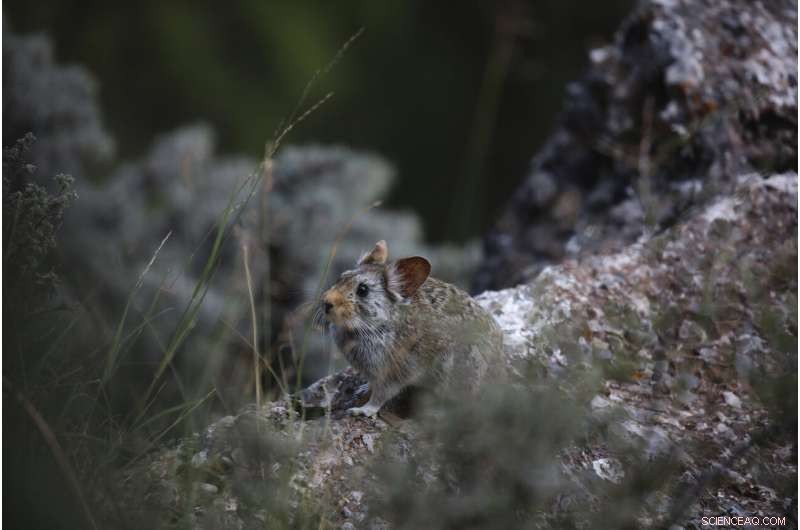
A Glover's Pika surveys its surrounding in Angsai, an area inside the Sanjiangyuan region in western China's Qinghai province on Tuesday, 27 agosto 2019. (AP Photo/Ng Han Guan)
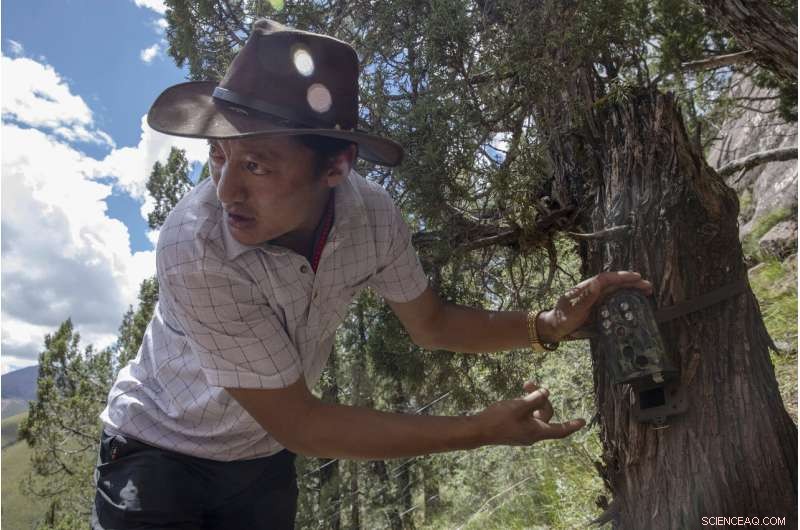
Kunchok Jangtse positions a camera trap in Angsai, an area inside the Sanjiangyuan region in western China's Qinghai province on Tuesday, 27 agosto 2019. The Tibetan herder also has a job installing and maintaining the motion-activated cameras, which help scientists monitor endangered species in the area. "Our religion is connected with wild animals, because wild animals have a consciousness and can feel love and compassion—therefore, we protect wild-animals, " he says. (AP Photo/Ng Han Guan)
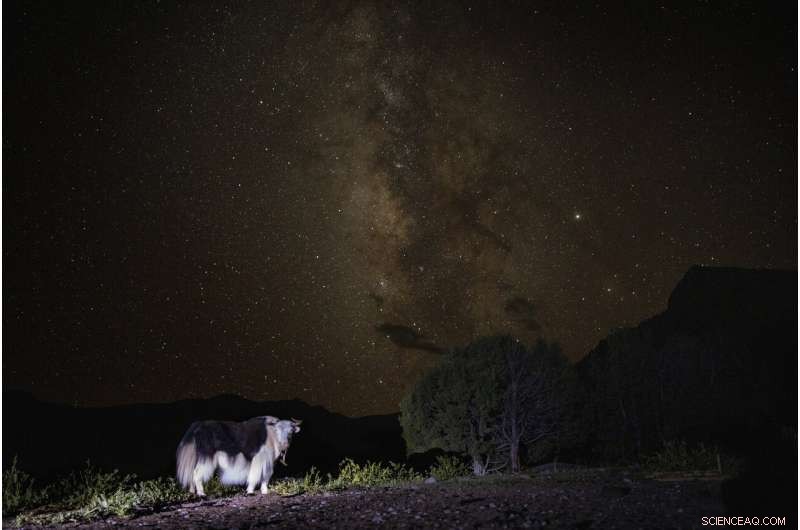
The Milky Way glows behind a yak in Angsai, an area inside the Sanjiangyuan region in western China's Qinghai province on Monday, Aug. 26, 2019. "This is one of the most special regions in China, in the world, " says Lu Zhi, a Peking University conservation biologist who has worked in Qinghai for two decades. (AP Photo/Ng Han Guan)
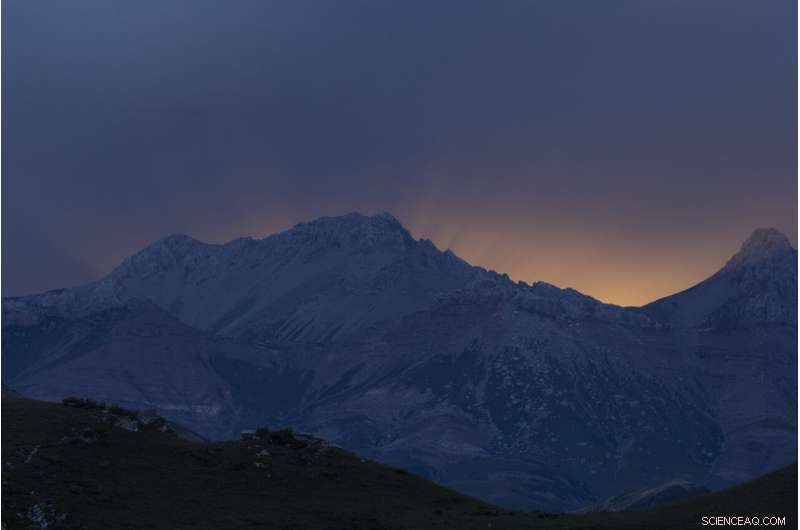
A sunset casts rays of light over the top of a mountain range in Angsai, an area inside the Sanjiangyuan region in western China's Qinghai province on Monday, Aug. 26, 2019. "This is one of the most special regions in China, in the world, " says Lu Zhi, a Peking University conservation biologist who has worked in Qinghai for two decades. (AP Photo/Ng Han Guan)

A bat flies through a narrow crevice in Wuyishan in eastern China's Fujian province on Tuesday, Aug. 13, 2019. (AP Photo/Ng Han Guan)

A monkey bares its teeth at visitors in an animal shelter that is part of tourist site in Wuyishan in eastern China's Fujian province on Friday, Aug. 16, 2019. (AP Photo/Ng Han Guan)
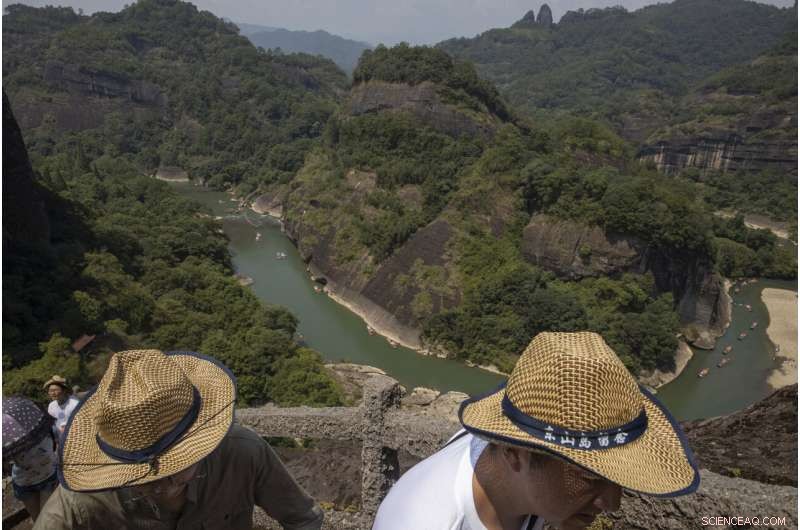
Visitors climb Tianyou peak in Wuyishan in eastern China's Fujian province on Wednesday, 14 agosto 2019. The ambition to create a unified park system represents "a new and serious effort to safeguard China's biodiversity and natural heritage, " says Duke University ecologist Stuart Pimm. (AP Photo/Ng Han Guan)

Women work on a photo for their tea products on a mountain top in Wuyishan in eastern China's Fujian province on Wednesday, 14 agosto 2019. Zhu Chunquan, the China representative of the International Union for the Conservation of Nature, a Switzerland-based scientific group, notes that the country's economy has boomed over the past 40 years. But priorities are now expanding to include conserving the country's key natural resources. "It's quite urgent, as soon as possible to identify the places, the ecosystems and other natural features" to protect, Zhu says. (AP Photo/Ng Han Guan)
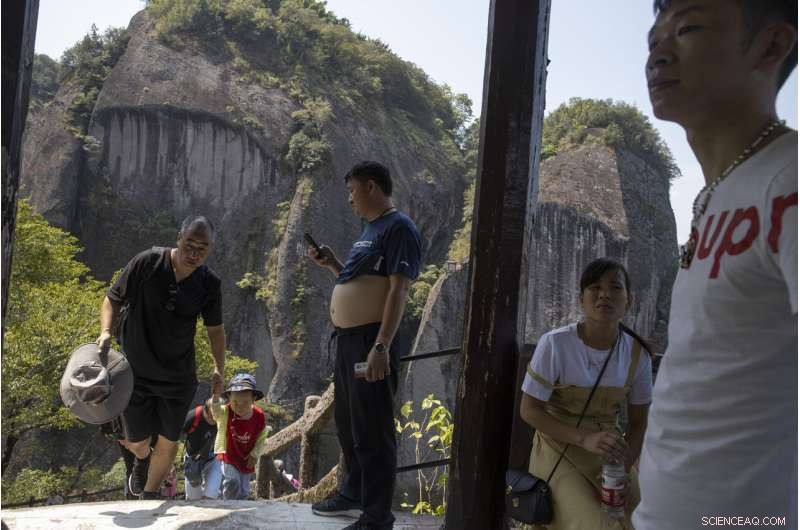
Visitors rest in a pavilion during a climb up Tianyou peak in Wuyishan in eastern China's Fujian province on Wednesday, 14 agosto 2019. (AP Photo/Ng Han Guan)
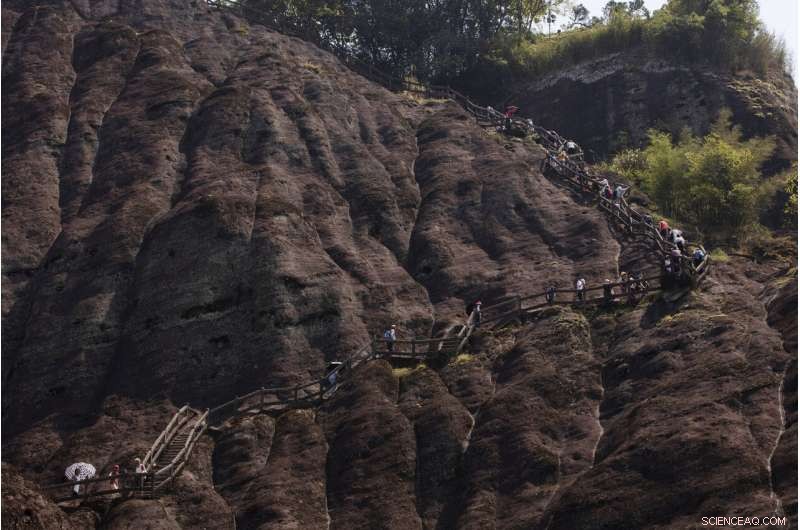
Visitors climb Tianyou peak in Wuyishan in eastern China's Fujian province on Wednesday, 14 agosto 2019. (AP Photo/Ng Han Guan)
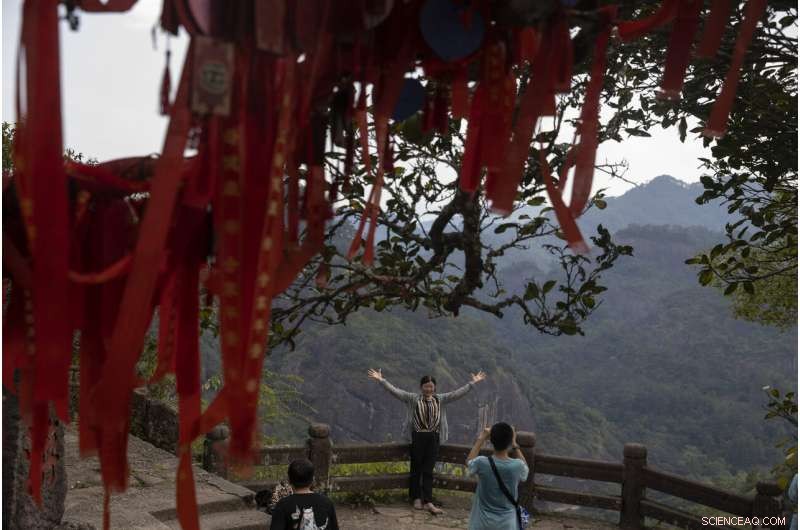
A visitor poses for a photo on Tianyou peak in Wuyishan in eastern China's Fujian province on Wednesday, 14 agosto 2019. (AP Photo/Ng Han Guan)
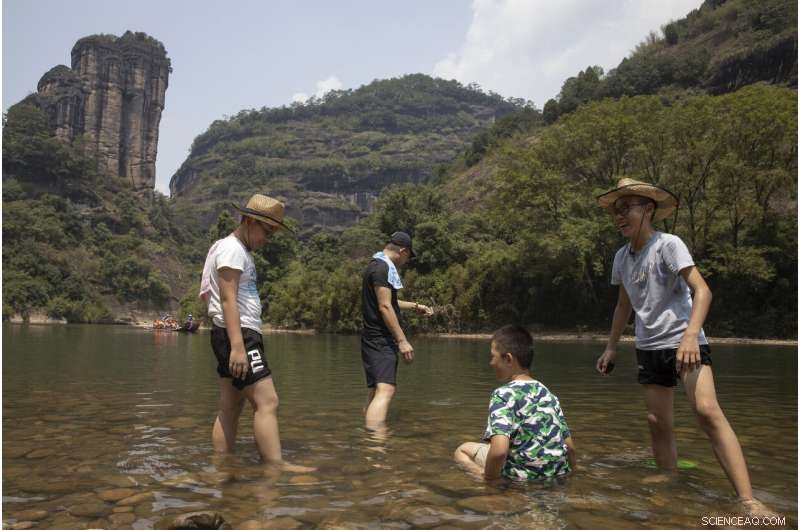
A woman poses for photos near a waterfall in Wuyishan in eastern China's Fujian province on Thursday, 15 agosto 2019. (AP Photo/Ng Han Guan)

Tourists stand in shallow water along the Nine Bends River in Wuyishan in eastern China's Fujian province on Thursday, 15 agosto 2019. (AP Photo/Ng Han Guan)
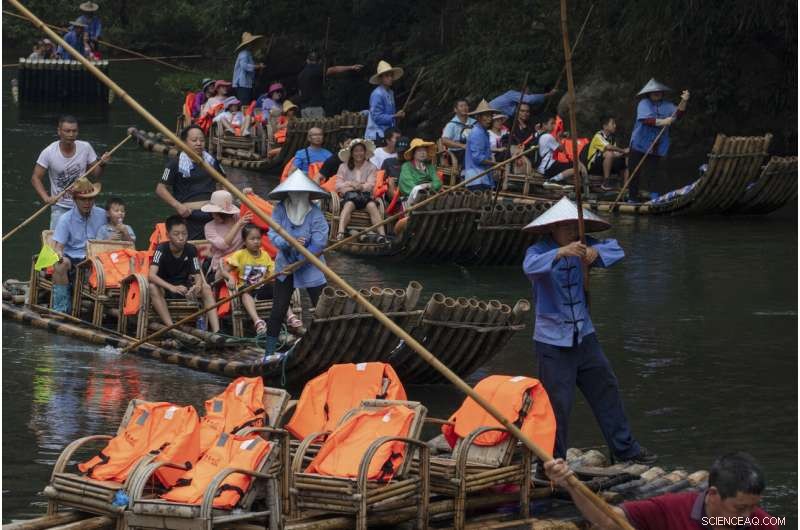
Tourists ride in bamboo rafts during a tour of the Nine Bends River in Wuyishan in eastern China's Fujian province on Thursday, 15 agosto 2019. In August 2019, policymakers and scientists from China, the United States and other countries met in China to discuss the country's plans to create a unified park system with clear standards for limiting development and protecting ecosystems. (AP Photo/Ng Han Guan)

A boy holds a water rifle on the banks of the Nine Bends River as bamboo raft operators wait for tourists in Wuyishan in eastern China's Fujian province on Thursday, 15 agosto 2019. Zhu Chunquan, the China representative of the International Union for the Conservation of Nature, a Switzerland-based scientific group, notes that the country's economy has boomed over the past 40 years. But priorities are now expanding to include conserving the country's key natural resources. "It's quite urgent, as soon as possible to identify the places, the ecosystems and other natural features" to protect, Zhu says. (AP Photo/Ng Han Guan)
Now Ouyang is drawing upon that work, combined with surveys of more than 1, 500 species of endangered and threatened plants and animals, to map priority areas for conservation and advise park planners. He is focusing on habitats of endangered species that live only in China.
"If we lose it here, è andato, " lui dice.
The first parks to be formally incorporated into China's national park system will showcase the country's vast and varied landscapes and ecosystems—from the granite and sandstone cliffs of Wuyishan in eastern China to the lush forests of southwestern Sichuan province, home to giant pandas, to the boreal forests of northeastern China, where endangered Siberian tigers roam.
When it comes to ecology, few countries have more to lose, or to save, than China.
"A huge country like China literally determines the fate of species, " says Duke University's Pimm.
© 2019 The Associated Press. Tutti i diritti riservati.